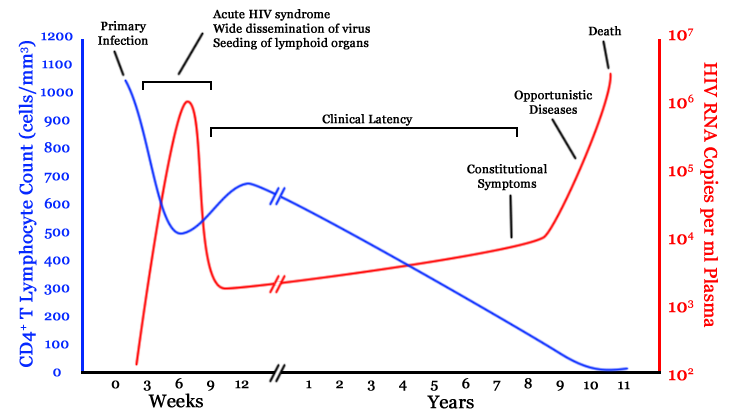HIV AIDS history and symptoms
|
AIDS Microchapters |
|
Diagnosis |
|
Treatment |
|
Case Studies |
|
HIV AIDS history and symptoms On the Web |
|
American Roentgen Ray Society Images of HIV AIDS history and symptoms |
|
Risk calculators and risk factors for HIV AIDS history and symptoms |
Editor-In-Chief: C. Michael Gibson, M.S., M.D. [1]
Overview
Acute HIV should be suspected in patients with flu-like or mononucleosis-like symptoms within 2-4 weeks of exposure to HIV virus or participation in high risk behaviors. Although a significant proportion of patients are asymptomatic, those who manifest an acute illness present with fever, lymphadenopathy, rash, fatigue, and myalgia. This stage is usually followed by a clinical latency period throughout which patients may not experience any symptoms. AIDS defines the final stage of HIV infection and indicates significant immune compromise. AIDS classically presents with weight loss, night sweats, fatigue, and symptoms of opportunistic infections (or AIDS-defining illnesses) such as diarrhea, mucosal sores, cough, and cognitive and neurological deficits.
History
 |
- AIDS should be suspected in patients with flu like symptoms within 2-4 weeks of exposure to HIV virus or participated in a high risk behaviour like unprotected sex with patners of unknown HIV status or sharing needles or contaminated blood transfusion.
- Many people describe the flu as very severe and "worst flu ever"
- Many HIV positive people do not have any symptoms and will not complain of any symtoms untill they progress to full blown AIDS
- HIV affects nearly every organ system. People with AIDS also have an increased risk of developing various cancers such as Kaposi's sarcoma, cervical cancer and cancers of the immune system known as lymphomas.
- After the diagnosis of AIDS is made, the current average survival time with antiretroviral therapy (as of 2005) is estimated to be more than 5 years,[1] but because new treatments continue to be developed and because HIV continues to evolve resistance to treatments, estimates of survival time are likely to continue to change. Without antiretroviral therapy, death normally occurs within a year. Most patients die from opportunistic infections or malignancies associated with the progressive failure of the immune system.[2]
- The rate of clinical disease progression varies widely between individuals and has been shown to be affected by many factors such as host susceptibility and immune function health care and co-infections,[2] as well as factors relating to the viral strain.[3][4]
- The specific opportunistic infections that AIDS patients develop depend in part on the prevalence of these infections in the geographic area in which the patient lives.
Symptoms
Acute Retroviral Syndrome
- Within 2-4 weeks after HIV infection, patients may complain of flu-like or mononucleosis-like symptoms. This phase is known as the acute retroviral syndrome. The common symptoms include:
Clinical Latency Stage
Patient may experience no symptoms or mild symptoms. Virus can be detected at this stage and patients are able to transmit the disease at this stage.
AIDS
Symptoms can include the following.
- Rapid weight loss
- Recuring fever or profuse night sweats
- Extreme and unexplained tiredness
- Prolonged swollen lymph nodes
- Diarrhea lasting more than a week.
- Sores of mouth , anus or genitals
- Pneumonia
- Red , brown or pink rashes.
- Memory loss, depression and other neurological disorders.
Symptoms of Opportunistic Infections
Opportunistic infections can produce a wide variety of symptoms that can often unmask AIDS in patients without previously documented HIV infection. These infections are known as AIDS-defining illnesses.
Pulmonary Infections
- Cough
- Dry: Suggestive of Pneumocystis jirovecii pneumonia
- Productive: Suggestive of bacterial or fungal pneumonia
- Hemoptysis
- Suggestive of tuberculosis or fungal pneumonia
- Dyspnea
- Chest pain
Gastrointestinal Infections
- Chest pain
- Suggestive of esophageal candidiasis
- Abdominal pain
- Suggestive of bacterial gastroenteritis, cytomegalovirus (CMV) colitis, or Clostridium difficile colitis
- Chronic diarrhea
- Suggestive of cryptosporidiosis, cytomegalovirus (CMV) colitis, or Clostridium difficile colitis
- Bloody diarrhea
- Suggestive of invasive bacterial gastroenteritis, cytomegalovirus (CMV) colitis or Clostridium difficile colitis
Neurological Diseases
- Focal neurological deficits
- Suggestive of cerebral toxoplasmosis, Progressive multifocal leukoencephalopathy (PML), primary CNS lymphoma, or disseminated TC or MAC
- Memory loss and cognitive decline
- Suggestive of AIDS-Dementia complex or primary CNS lymphoma
- Fever, headache, meningeal signs and symptoms
- Suggestive of meningitis, consider cryptococcal meningitis
Skin and Mucosal Disease
- Purpulish rash that responds poorly to treatment
- Suggestive of Kaposi's sarcoma or bacillary angiomatosis
- Massive lymphadenopathy
- Suggestive of malignant lymphoma
- Mucosal leasions that respond poorly to treatment
- Suggestive of HPV related tumors (Oral/Anal squamous cell carcinoma, invasive cervical cancer)
Other manifestations
- Blurry vision or vision loss
- Suggestive of CMV retinitis
References
- ↑ Schneider MF, Gange SJ, Williams CM, Anastos K, Greenblatt RM, Kingsley L, Detels R, Munoz A (2005). "Patterns of the hazard of death after AIDS through the evolution of antiretroviral therapy: 1984–2004". AIDS. 19 (17): 2009&ndash, 2018. PMID 16260908.
- ↑ 2.0 2.1 Lawn SD (2004). "AIDS in Africa: the impact of coinfections on the pathogenesis of HIV-1 infection". J. Infect. Dis. 48 (1): 1&ndash, 12. PMID 14667787.
- ↑ Campbell GR, Watkins JD, Esquieu D, Pasquier E, Loret EP, Spector SA (2005). "The C terminus of HIV-1 Tat modulates the extent of CD178-mediated apoptosis of T cells". J. Biol. Chem. 280 (46): 38376&ndash, 39382. PMID 16155003.
- ↑ Senkaali D, Muwonge R, Morgan D, Yirrell D, Whitworth J, Kaleebu P (2005). "The relationship between HIV type 1 disease progression and V3 serotype in a rural Ugandan cohort". AIDS Res. Hum. Retroviruses. 20 (9): 932&ndash, 937. PMID 15585080.